Estimated reading time: 8 minutes
Pruning apple trees is top of mind in winter. They are some of the most popular, reliable, and commonly grown fruit trees, and are common in backyards.
Apples grow in most climates, and there are hundreds of varieties readily available. As long as you look after pest and disease control, it’s possible to harvest fresh apples from early summer through to mid-winter.
They also store well, making them effectively available all year long.
Every garden needs an apple tree
Can you tell we love apples? They’re one of our favourite backyard fruit trees, and we’re always keen to pass on what we’ve learned about growing them the organic way.
Apple and pear trees vary in their fruitfulness and growth habits. This is due to a combination of variety, rootstock, growing system, climate, and situation.
It’s important to get to know your tree and vary your pruning in response to the individual tree.
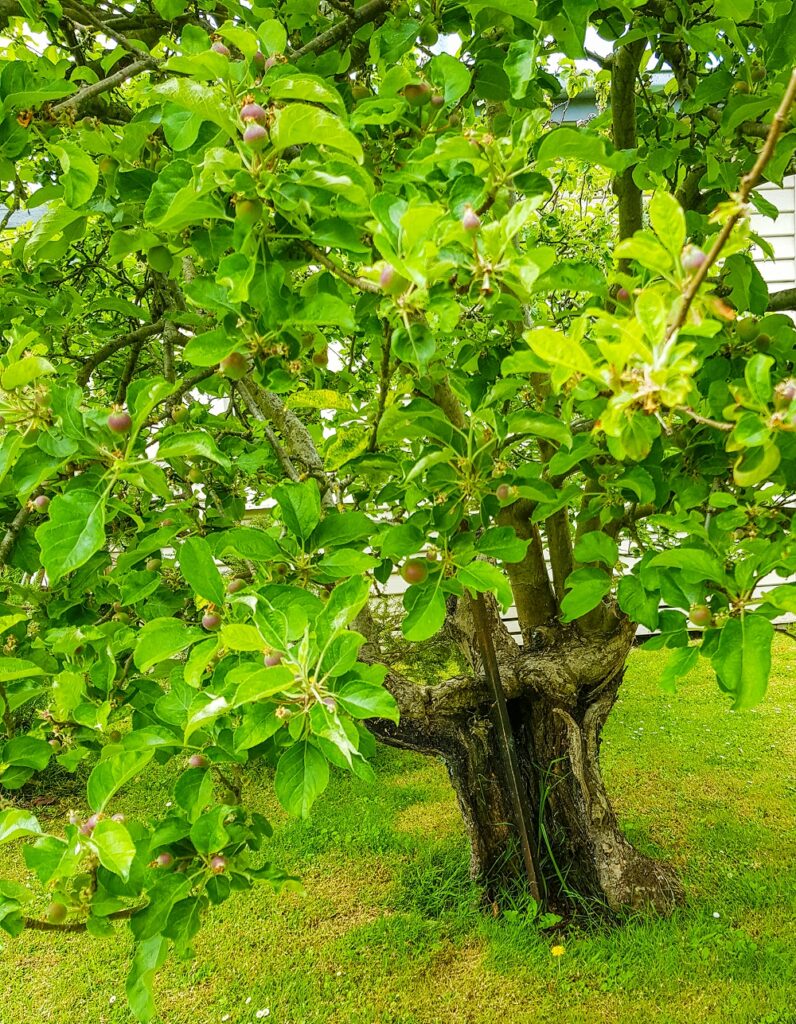
The basics of pruning apple trees are the same as pruning other fruit trees. However, there are a couple of extra factors you need to consider about apple trees.
The first is that some varieties of apples are spur bearers and some are tip bearers, and they need to be pruned differently. More on that in a moment.
The other factor that can influence apple tree pruning is that they can be grown on lots of different rootstocks, so let’s start there.
Dwarfing vs full-size fruit trees
Apple trees are grafted onto apple rootstock, and there are many different types available. The rootstock determines the ultimate size of your apple tree. It can also give it other characteristics, such as disease resistance.
The largest type of rootstock available is seedling (literally, grown from seed). These rootstocks develop into long-lived and resilient trees with good drought and flood resistance. They can grow up to 5 to 6 metres tall (or bigger), though the size can be kept smaller with appropriate pruning.
All other rootstocks are smaller than seedlings. Some of the more commonly available semi-dwarfing and dwarfing rootstocks include:
- MM111 (about 80% the size of a seedling)
- MM106 (about 70%)
- MM102 (about 55%) – this is the dwarfing rootstock we use here on the farm in Carr’s Organic Fruit Tree Nursery
- M26 (about 40%)
- M9 (about 25%), and
- M27 (about 15%)
Before you start to prune your apple tree, it’s good to know what rootstock it’s on, if possible. This can help you decide what shape you’re aiming for.
If you’re not sure, and it’s obvious that your tree is not a dwarf, it’s usually easiest to prune it into a vase shape.
The larger and medium-sized rootstocks are well-suited to vase-shaped trees. The medium-sized rootstocks lend themselves well to espaliers and fans, and the smaller rootstocks work well on trellis systems or as free-standing pyramids.
However, it’s also possible to grow larger trees on a trellis; you just need to have a trellis that’s big enough to take it!
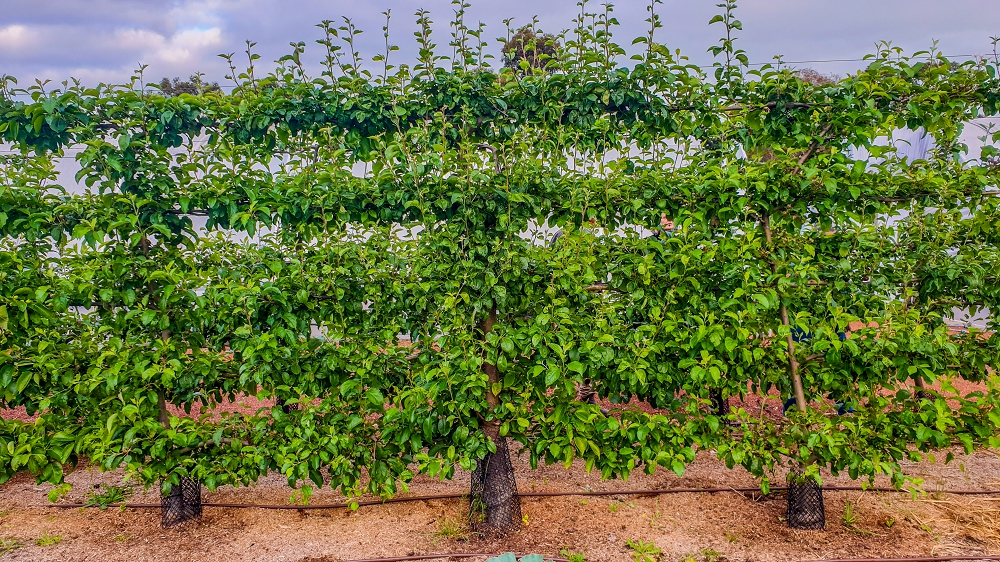
Tip bearing vs spur bearing: understanding how apple trees grow
Most apples and pears are spur-bearers. This means they bear fruit on wood that is 2 years old or older. This wood is in the form of short fruit-bearing shoots known as spurs.
Spur-bearing varieties tend to have slow-growing leafy shoots and a mixed terminal bud (both leaves and flowers). They are best for espaliers, fans, and trellis systems. Both tip and spur-bearing varieties suit vase-shaped trees.
Far fewer varieties are tip-bearers, which bear fruit as clusters near the tips of longer shoots. They have a lot fewer spurs and greater lengths of bare wood between the buds and shoots.
Some varieties are both tip and spur bearing.
It’s good to know what type of apple or pear tree you have before you start pruning. If you’re not sure, wait until the tree flowers in spring to decide where to prune.
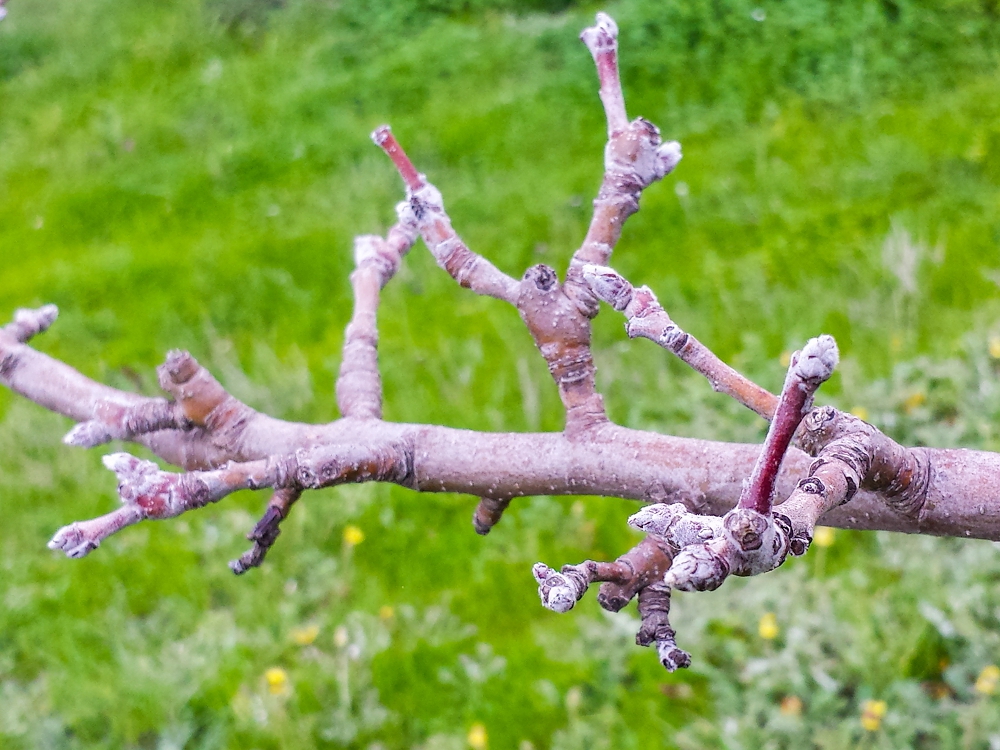
How to prune spur-bearing apples
- Old spurs have few fruit buds, so on older trees, thin any spurs that have become overcrowded. Only remove them completely if there are replacement young shoots nearby.
- Laterals can be shortened to encourage spurs to form. Shorten the laterals on each main branch to about 5 or 6 buds for strong laterals, or 2 or 3 buds for weaker laterals. Cut them back neatly to a bud. This will encourage the development of new side shoots and spurs. Short laterals can be left unpruned.
- On a 2-year-old spur (i.e., a lateral that was shortened the previous year), it will most likely have branched into 2 or 3 new laterals. Shorten each of them, as this will help to encourage the development of spurs.
- On really large, vigorous trees, it’s impractical to shorten every single lateral. Make larger pruning cuts to remove part or all of some of the more crowded branches.
- Horizontal wood grows spurs and develops fruit buds more easily than vertical wood.
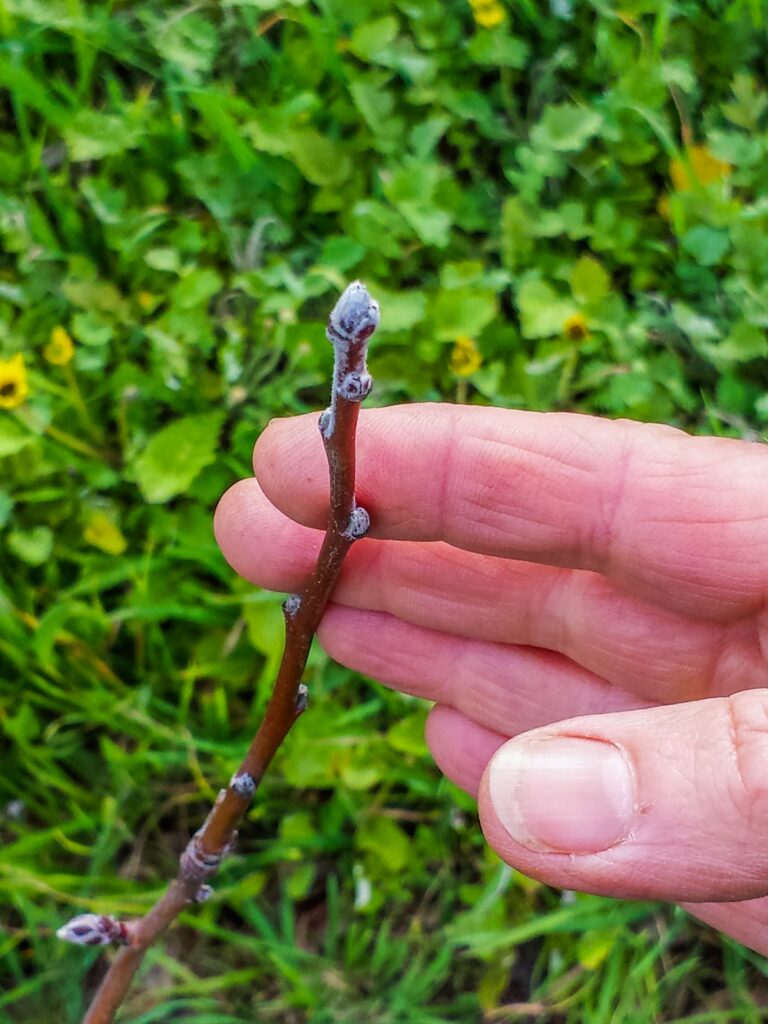
How to prune tip-bearing apples
- Identify the new growth (laterals, or side shoots) on your tree. They are usually a different colour from the older wood. The buds on the ends of these new shoots are terminal (or apical) buds. This is the main place where fruit will grow on your tree in the coming season. It’s important not to cut too many of these off when pruning, or your tree won’t have any fruit.
- Fruit buds are fat and furry; leaf buds are slender and smooth.
- On mature trees that have been fruiting, use renewal pruning to remove a proportion of older fruiting laterals back to a new side shoot to favour new growth. You can also shorten them to one or two buds, or remove them completely if there are plenty of new replacement shoots.
- Unlike spur-bearing varieties, where most or all laterals are shortened, leave all the other laterals unpruned on tip-bearing varieties, as they will carry this year’s fruit crop.
When is the best time to prune apple trees?
As we often say, there’s no right or wrong with pruning, just cuts and consequences. They can be pruned at any time of year – you’ll just get slightly different consequences.
Apple and pear trees are normally pruned in winter, and it’s certainly easier to see what you’re doing when the trees have no leaves. If possible, try to finish pruning before the trees start flowering (unless you’re waiting for the flowers to see where to prune your tree!).
Apples and pears that are growing on more formally trained systems, such as espalier, fan, or trellis, will probably also need summer pruning.
This helps to control the strong upright growths (called ‘watershoots’) that are often produced by horizontal limbs. These new laterals should be shortened back to three leaves above the basal cluster of leaves, or if they are growing from an existing lateral or spur, you may want to prune them back even harder.
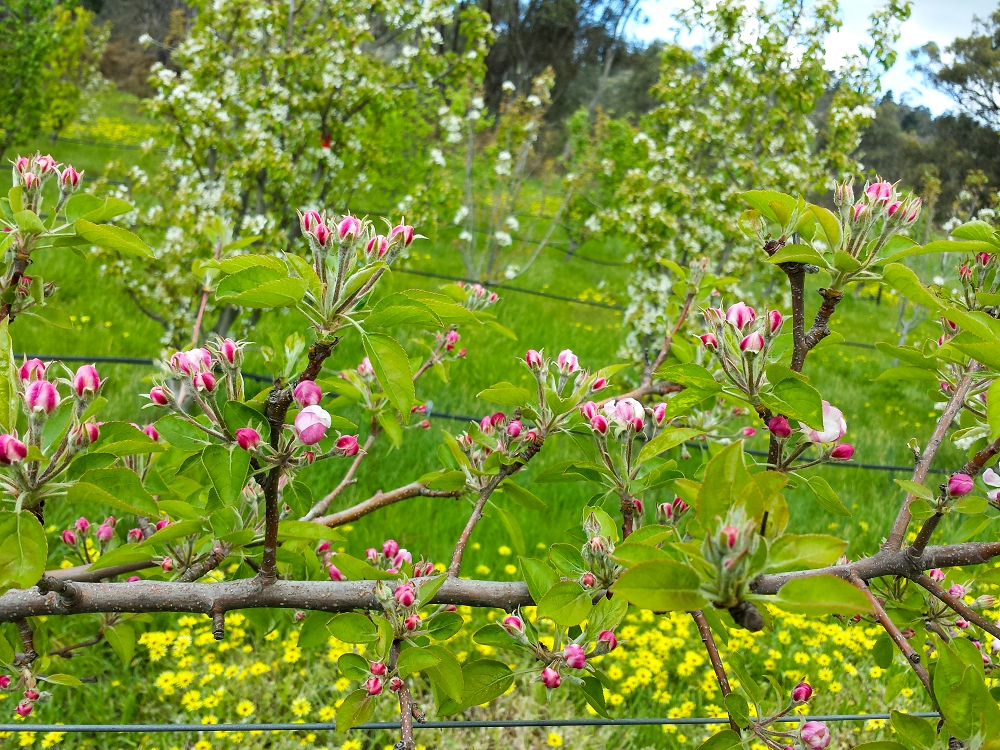
Related Articles
Taming monster fruit trees with renovation pruning
Learn how to use a technique called renovation pruning to tame large, unpruned, and out-of-control monster fruit trees.
How to plant a fruit tree – the easy way
Everything you need to know about how to plant your new fruit trees to get them off to a great start in life.
How to grow your own multigraft or fruit salad tree
Multigraft trees are a no-brainer for many gardens, as they reduce risk and provide a bigger variety of fruit, without taking up more space.

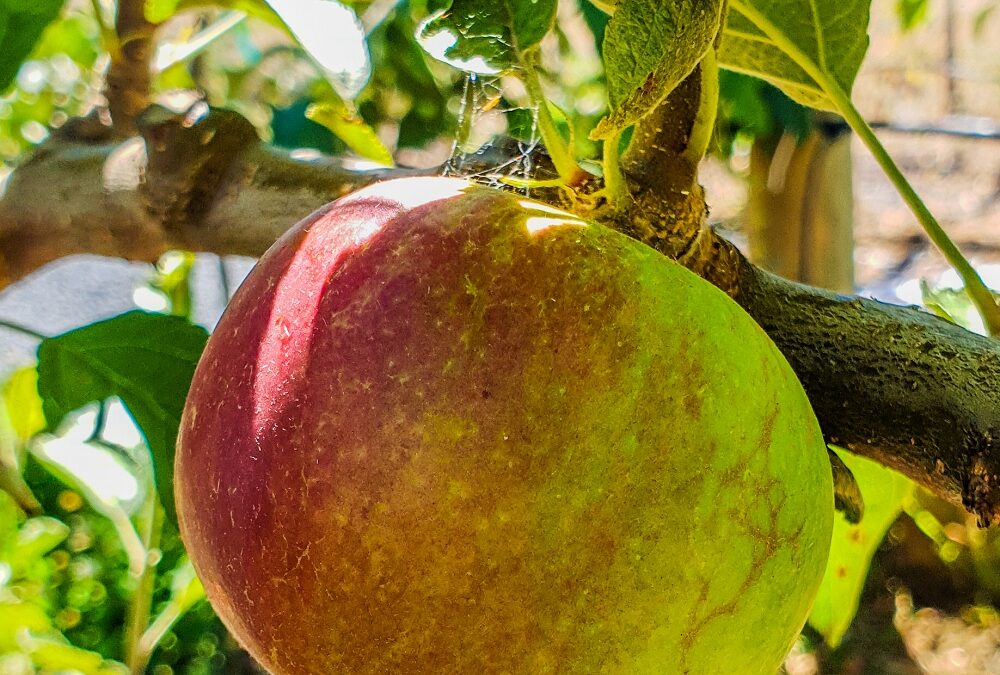

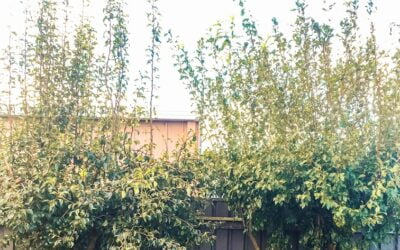

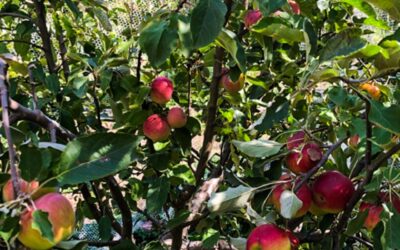


When thinning fruit after fruit set, how many apples do you leave in each bunch?
Hi Toni, we usually recommend leaving only one apple per bunch, but it depends on a few variables – the crop load (whether it’s heavy, light, or medium), the size and age of the tree, and even the weather. There’s a chart to help you figure out the best number of fruit to leave for each tree in this short course: https://growgreatfruit.com/product/fruit-tree-thinning/
great tips and advice, as always easy to understand and follow.
My favourite place is in my garden loaded with plants and loaded fruit trees along the fence line, best tasting and easy caring.
Sadly, will miss my garden and labour of love fruits … will be selling our home here by Port Phillip Bay …no doubt others will savour the treasures found within the property line.
Thanks for the feedback! And sounds like a garden you would definitely miss – very lucky new owners whoever they may be. Meg – Grow Great Fruit team.
Im keen to have an expert come and show me techniques for my fruit trees. Is there anyone in Adelaide you might know of who does this?
Hi Dyan, Sorry, can’t help with anyone in Adelaide, but did you know that we do online live pruning with our Premium members?! Yes, it’s a thing! We’ll have a Zoom call and the member will point their camera at their tree and we then give instructions as to what to do – it’s suprisingly effective! This may suit you.
To check out the program, please click here: https://growgreatfruit.com/grow-great-fruit-program-sign-up/. And note that we have a sale on Premium Annual membership at the moment: https://growgreatfruit.com/product/grow-great-fruit-program-premium-offer/
How do you suggest pruning ballerina column apple trees please?
Hi Tina, the main thing you want to prioritise with a ballerina apple is to maintain that central leader (i.e. don’t prune that!) and then focus on shortening your laterals whilst retaining fruiting spurs. Knowing the parts of your fruit tree before you start pruning can really help with a slightly more technical prune like a ballerina, just so you can be confident in identifying which part of the tree is doing what. This blog might help with that. Hope that helps! Meg – GGF team.
Is it ok to prune apples (including crab apples) and pears if a frost is expected the next day?
Hi Veronika, It really depends on the scale of your pruning. I may not do a big renovation prune if there was a risk of very heavy frost the next day, but a normal maintenance prune should be fine! Meg – GGF team.
Hello, our apple trees are late loosing their leaves; all the other fruit trees are bare. I’m hesitant to prune them before they have lost their leaves. Is it okay to go ahead despite the green leaves?
Thanks for the great advice and tips.
Hi David, yes it’s best to wait until most or all of the leaves have fallen off! Meg – GGF team.